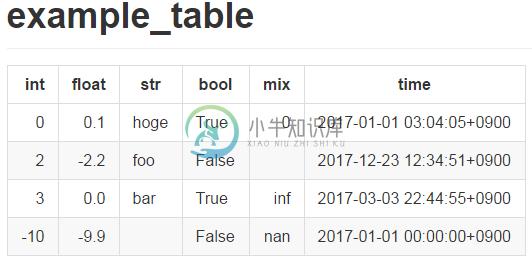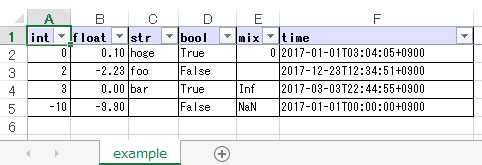pytablewriter
Summary
pytablewriter is a Python library to write a table in various formats: AsciiDoc / CSV / Elasticsearch / HTML / JavaScript / JSON / LaTeX / LDJSON / LTSV / Markdown / MediaWiki / NumPy / Excel / Pandas / Python / reStructuredText / SQLite / TOML / TSV / YAML.
Features
-
- Write a table in various formats:
-
-
- Text formats:
-
- AsciiDoc
- CSV / Tab-separated values (TSV) / Space-separated values (SSV)
- HTML / CSS
- JSON / Line-delimited JSON(LDJSON)
- Labeled Tab-separated Values (LTSV)
- LaTeX:
tabular/arrayenvironment - Markdown: CommonMark / GitHub Flavored Markdown (GFM) / kramdown
- MediaWiki
- reStructuredText: Grid Tables/Simple Tables/CSV Table
-
- Source code (definition of a variable that represents tabular data)
-
- JavaScript / NumPy (numpy.array) / Pandas (pandas.DataFrame) / Python
- TOML
- YAML
- Unicode
-
- Binary file formats:
-
- Microsoft Excel TM (
.xlsx/.xlsfile format) - pandas.DataFrame pickle file
- SQLite database
- Microsoft Excel TM (
-
- Application specific formats:
-
-
- Automatic table cell formatting:
-
- Alignment
- Padding
- Decimal places of numbers
-
- Customize table cell styles:
-
- Text/Background color
- Text alignment
- Font size/weight
- Thousand separator for numbers: e.g.
1,000/1 000
-
- Configure output:
-
- Write table to a stream such as a file/standard-output/string-buffer/Jupyter-Notebook
- Get rendered tabular text
-
- Data sources:
-
- nested list
- CSV
- pandas.DataFrame / pandas.Series
- etc.
- Multibyte character support
- ANSI color support
Installation
Installation: pip
pip install pytablewriter
Some of the formats require additional dependency packages, you can install these packages as follows:
Installation of optional dependencies| Installation example | Remark |
|---|---|
pip install pytablewriter[es] |
Elasticsearch |
pip install pytablewriter[excel] |
Excel |
pip install pytablewriter[html] |
HTML |
pip install pytablewriter[sqlite] |
SQLite database |
pip install pytablewriter[toml] |
TOML |
pip install pytablewriter[theme] |
pytablewriter theme plugins |
pip install pytablewriter[all] |
Install all of the optional dependencies |
Installation: conda
conda install -c conda-forge pytablewriter
Installation: apt
sudo add-apt-repository ppa:thombashi/ppa sudo apt update sudo apt install python3-pytablewriter
Examples
Write tables
Write a Markdown table
| Sample Code: |
from pytablewriter import MarkdownTableWriter
def main():
writer = MarkdownTableWriter(
table_name="example_table",
headers=["int", "float", "str", "bool", "mix", "time"],
value_matrix=[
[0, 0.1, "hoge", True, 0, "2017-01-01 03:04:05+0900"],
[2, "-2.23", "foo", False, None, "2017-12-23 45:01:23+0900"],
[3, 0, "bar", "true", "inf", "2017-03-03 33:44:55+0900"],
[-10, -9.9, "", "FALSE", "nan", "2017-01-01 00:00:00+0900"],
],
)
writer.write_table()
if __name__ == "__main__":
main()
|
|---|---|
| Output: | # example_table
|int|float|str |bool | mix | time |
|--:|----:|----|-----|-------:|------------------------|
| 0| 0.10|hoge|True | 0|2017-01-01 03:04:05+0900|
| 2|-2.23|foo |False| |2017-12-23 12:34:51+0900|
| 3| 0.00|bar |True |Infinity|2017-03-03 22:44:55+0900|
|-10|-9.90| |False| NaN|2017-01-01 00:00:00+0900| |
| Rendering Result: |
Write a Markdown table with a margin
| Sample Code: |
from pytablewriter import MarkdownTableWriter
def main():
writer = MarkdownTableWriter(
table_name="write example with a margin",
headers=["int", "float", "str", "bool", "mix", "time"],
value_matrix=[
[0, 0.1, "hoge", True, 0, "2017-01-01 03:04:05+0900"],
[2, "-2.23", "foo", False, None, "2017-12-23 45:01:23+0900"],
[3, 0, "bar", "true", "inf", "2017-03-03 33:44:55+0900"],
[-10, -9.9, "", "FALSE", "nan", "2017-01-01 00:00:00+0900"],
],
margin=1 # add a whitespace for both sides of each cell
)
writer.write_table()
if __name__ == "__main__":
main()
|
|---|---|
| Output: | # write example with a margin
| int | float | str | bool | mix | time |
| --: | ----: | ---- | ----- | -------: | ------------------------ |
| 0 | 0.10 | hoge | True | 0 | 2017-01-01 03:04:05+0900 |
| 2 | -2.23 | foo | False | | 2017-12-23 12:34:51+0900 |
| 3 | 0.00 | bar | True | Infinity | 2017-03-03 22:44:55+0900 |
| -10 | -9.90 | | False | NaN | 2017-01-01 00:00:00+0900 | |
margin attribute can be available for all of the text format writer classes.
Write a table to an Excel sheet
| Sample Code: |
from pytablewriter import ExcelXlsxTableWriter
def main():
writer = ExcelXlsxTableWriter()
writer.table_name = "example"
writer.headers = ["int", "float", "str", "bool", "mix", "time"]
writer.value_matrix = [
[0, 0.1, "hoge", True, 0, "2017-01-01 03:04:05+0900"],
[2, "-2.23", "foo", False, None, "2017-12-23 12:34:51+0900"],
[3, 0, "bar", "true", "inf", "2017-03-03 22:44:55+0900"],
[-10, -9.9, "", "FALSE", "nan", "2017-01-01 00:00:00+0900"],
]
writer.dump("sample.xlsx")
if __name__ == "__main__":
main()
|
|---|---|
| Output: |
Write a Unicode table
| Sample Code: |
from pytablewriter import UnicodeTableWriter
def main():
writer = UnicodeTableWriter(
table_name="example_table",
headers=["int", "float", "str", "bool", "mix", "time"],
value_matrix=[
[0, 0.1, "hoge", True, 0, "2017-01-01 03:04:05+0900"],
[2, "-2.23", "foo", False, None, "2017-12-23 45:01:23+0900"],
[3, 0, "bar", "true", "inf", "2017-03-03 33:44:55+0900"],
[-10, -9.9, "", "FALSE", "nan", "2017-01-01 00:00:00+0900"],
]
)
writer.write_table()
if __name__ == "__main__":
main()
|
|---|---|
| Output: | ┌───┬─────┬────┬─────┬────────┬────────────────────────┐
│int│float│str │bool │ mix │ time │
├───┼─────┼────┼─────┼────────┼────────────────────────┤
│ 0│ 0.10│hoge│True │ 0│2017-01-01 03:04:05+0900│
├───┼─────┼────┼─────┼────────┼────────────────────────┤
│ 2│-2.23│foo │False│ │2017-12-23 12:34:51+0900│
├───┼─────┼────┼─────┼────────┼────────────────────────┤
│ 3│ 0.00│bar │True │Infinity│2017-03-03 22:44:55+0900│
├───┼─────┼────┼─────┼────────┼────────────────────────┤
│-10│-9.90│ │False│ NaN│2017-01-01 00:00:00+0900│
└───┴─────┴────┴─────┴────────┴────────────────────────┘ |
Write a table with JavaScript format (as a nested list variable definition)
| Sample Code: |
import pytablewriter as ptw
def main():
writer = ptw.JavaScriptTableWriter(
table_name="js_variable",
headers=["int", "float", "str", "bool", "mix", "time"],
value_matrix=[
[0, 0.1, "hoge", True, 0, "2017-01-01 03:04:05+0900"],
[2, "-2.23", "foo", False, None, "2017-12-23 45:01:23+0900"],
[3, 0, "bar", "true", "inf", "2017-03-03 33:44:55+0900"],
[-10, -9.9, "", "FALSE", "nan", "2017-01-01 00:00:00+0900"],
],
)
writer.write_table()
if __name__ == "__main__":
main()
|
|---|---|
| Output: |
const js_variable = [
["int", "float", "str", "bool", "mix", "time"],
[0, 0.1, "hoge", true, 0, "2017-01-01 03:04:05+0900"],
[2, -2.23, "foo", false, null, "2017-12-23 45:01:23+0900"],
[3, 0, "bar", true, Infinity, "2017-03-03 33:44:55+0900"],
[-10, -9.9, "", "FALSE", NaN, "2017-01-01 00:00:00+0900"]
];
|
Write a Markdown table from pandas.DataFrame instance
from_dataframe method of writer classes will set up tabular data from pandas.DataFrame:
| Sample Code: |
from textwrap import dedent
import pandas as pd
import io
from pytablewriter import MarkdownTableWriter
def main():
csv_data = io.StringIO(dedent("""\
"i","f","c","if","ifc","bool","inf","nan","mix_num","time"
1,1.10,"aa",1.0,"1",True,Infinity,NaN,1,"2017-01-01 00:00:00+09:00"
2,2.20,"bbb",2.2,"2.2",False,Infinity,NaN,Infinity,"2017-01-02 03:04:05+09:00"
3,3.33,"cccc",-3.0,"ccc",True,Infinity,NaN,NaN,"2017-01-01 00:00:00+09:00"
"""))
df = pd.read_csv(csv_data, sep=',')
writer = MarkdownTableWriter(dataframe=df)
writer.write_table()
if __name__ == "__main__":
main()
|
|---|---|
| Output: | | i | f | c | if |ifc|bool | inf |nan|mix_num | time |
|--:|---:|----|---:|---|-----|--------|---|-------:|-------------------------|
| 1|1.10|aa | 1.0| 1|True |Infinity|NaN| 1|2017-01-01 00:00:00+09:00|
| 2|2.20|bbb | 2.2|2.2|False|Infinity|NaN|Infinity|2017-01-02 03:04:05+09:00|
| 3|3.33|cccc|-3.0|ccc|True |Infinity|NaN| NaN|2017-01-01 00:00:00+09:00| |
Adding a column of the DataFrame index if you specify add_index_column=True:
| Sample Code: |
import pandas as pd
import pytablewriter as ptw
def main():
writer = ptw.MarkdownTableWriter(table_name="add_index_column")
writer.from_dataframe(
pd.DataFrame({"A": [1, 2], "B": [10, 11]}, index=["a", "b"]),
add_index_column=True,
)
writer.write_table()
if __name__ == "__main__":
main()
|
|---|---|
| Output: | # add_index_column
| | A | B |
|---|--:|--:|
|a | 1| 10|
|b | 2| 11| |
Write a markdown table from a space-separated values
| Sample Code: |
import pytablewriter as ptw
def main():
writer = ptw.MarkdownTableWriter(table_name="ps")
writer.from_csv(
"""
USER PID %CPU %MEM VSZ RSS TTY STAT START TIME COMMAND
root 1 0.0 0.4 77664 8784 ? Ss May11 0:02 /sbin/init
root 2 0.0 0.0 0 0 ? S May11 0:00 [kthreadd]
root 4 0.0 0.0 0 0 ? I< May11 0:00 [kworker/0:0H]
root 6 0.0 0.0 0 0 ? I< May11 0:00 [mm_percpu_wq]
root 7 0.0 0.0 0 0 ? S May11 0:01 [ksoftirqd/0]
""",
delimiter=" ",
)
writer.write_table()
if __name__ == "__main__":
main()
|
|---|---|
| Output: | # ps
|USER|PID|%CPU|%MEM| VSZ |RSS |TTY|STAT|START|TIME| COMMAND |
|----|--:|---:|---:|----:|---:|---|----|-----|----|--------------|
|root| 1| 0| 0.4|77664|8784|? |Ss |May11|0:02|/sbin/init |
|root| 2| 0| 0.0| 0| 0|? |S |May11|0:00|[kthreadd] |
|root| 4| 0| 0.0| 0| 0|? |I< |May11|0:00|[kworker/0:0H]|
|root| 6| 0| 0.0| 0| 0|? |I< |May11|0:00|[mm_percpu_wq]|
|root| 7| 0| 0.0| 0| 0|? |S |May11|0:01|[ksoftirqd/0] | |
Get rendered tabular text as str
dumps method returns rendered tabular text.dumps only available for text format writers.
| Sample Code: |
import pytablewriter as ptw
def main():
writer = ptw.MarkdownTableWriter(
headers=["int", "float", "str", "bool", "mix", "time"],
value_matrix=[
[0, 0.1, "hoge", True, 0, "2017-01-01 03:04:05+0900"],
[2, "-2.23", "foo", False, None, "2017-12-23 45:01:23+0900"],
[3, 0, "bar", "true", "inf", "2017-03-03 33:44:55+0900"],
[-10, -9.9, "", "FALSE", "nan", "2017-01-01 00:00:00+0900"],
],
)
print(writer.dumps())
if __name__ == "__main__":
main()
|
|---|---|
| Output: | |int|float|str |bool | mix | time |
|--:|----:|----|-----|-------:|------------------------|
| 0| 0.10|hoge|True | 0|2017-01-01 03:04:05+0900|
| 2|-2.23|foo |False| |2017-12-23 45:01:23+0900|
| 3| 0.00|bar |True |Infinity|2017-03-03 33:44:55+0900|
|-10|-9.90| |False| NaN|2017-01-01 00:00:00+0900| |
Configure table styles
Column styles
Writers can specifyStylefor each column by column_styles attribute of writer classes.
| Sample Code: |
import pytablewriter as ptw
from pytablewriter.style import Style
def main():
writer = ptw.MarkdownTableWriter(
table_name="set style by column_styles",
headers=[
"auto align",
"left align",
"center align",
"bold",
"italic",
"bold italic ts",
],
value_matrix=[
[11, 11, 11, 11, 11, 11],
[1234, 1234, 1234, 1234, 1234, 1234],
],
column_styles=[
Style(),
Style(align="left"),
Style(align="center"),
Style(font_weight="bold"),
Style(font_style="italic"),
Style(font_weight="bold", font_style="italic", thousand_separator=","),
], # specify styles for each column
)
writer.write_table()
if __name__ == "__main__":
main()
|
|---|---|
| Output: | # set style by styles
|auto align|left align|center align| bold |italic|bold italic ts|
|---------:|----------|:----------:|-------:|-----:|-------------:|
| 11|11 | 11 | **11**| _11_| _**11**_|
| 1234|1234 | 1234 |**1234**|_1234_| _**1,234**_| |
You can also set Style to a specific column with index or header by using set_style method:
| Sample Code: |
from pytablewriter import MarkdownTableWriter
from pytablewriter.style import Style
def main():
writer = MarkdownTableWriter()
writer.headers = ["A", "B", "C",]
writer.value_matrix = [[11, 11, 11], [1234, 1234, 1234]]
writer.table_name = "set style by column index"
writer.set_style(1, Style(align="center", font_weight="bold"))
writer.set_style(2, Style(thousand_separator=" "))
writer.write_table()
writer.write_null_line()
writer.table_name = "set style by header"
writer.set_style("B", Style(font_style="italic"))
writer.write_table()
if __name__ == "__main__":
main()
|
|---|---|
| Output: | # set style by column index
| A | B | C |
|---:|:------:|----:|
| 11| **11** | 11|
|1234|**1234**|1 234|
# set style by header
| A | B | C |
|---:|-----:|----:|
| 11| _11_| 11|
|1234|_1234_|1 234| |
Style filter
The following command will install external predefined themes:
pip install pytablewriter[theme]
theme argument of writer constructor or set_theme method can set"" predefined style filters.altrow theme will colored rows alternatively:
| Sample Code: |
import pytablewriter as ptw
writer = ptw.TableWriterFactory.create_from_format_name(
"markdown",
headers=["INT", "STR"],
value_matrix=[[1, "hoge"], [2, "foo"], [3, "bar"]],
margin=1,
theme="altrow",
)
writer.write_table()
|
|---|---|
| Output: |
Themes can be created as plugins like as follows:https://github.com/thombashi/pytablewriter-altrow-theme
Make tables for specific applications
Render a table on Jupyter Notebook
Multibyte character support
Write a table using multibyte character
You can use multibyte characters as table data.Multibyte characters also properly padded and aligned.
| Sample Code: |
import pytablewriter as ptw
def main():
writer = ptw.RstSimpleTableWriter(
table_name="生成に関するパターン",
headers=["パターン名", "概要", "GoF", "Code Complete[1]"],
value_matrix=[
["Abstract Factory", "関連する一連のインスタンスを状況に応じて、適切に生成する方法を提供する。", "Yes", "Yes"],
["Builder", "複合化されたインスタンスの生成過程を隠蔽する。", "Yes", "No"],
["Factory Method", "実際に生成されるインスタンスに依存しない、インスタンスの生成方法を提供する。", "Yes", "Yes"],
["Prototype", "同様のインスタンスを生成するために、原型のインスタンスを複製する。", "Yes", "No"],
["Singleton", "あるクラスについて、インスタンスが単一であることを保証する。", "Yes", "Yes"],
],
)
writer.write_table()
if __name__ == "__main__":
main()
|
|---|---|
| Output: |
Multi processing
You can increase the number of workers to process table data via max_workers attribute of a writer.The more max_workers the less processing time when tabular data is large and the execution environment has available cores.
if you increase max_workers larger than one, recommend to use main guarded as follows to avoid problems caused by multi processing:
from multiprocessing import cpu_count
import pytablewriter as ptw
def main():
writer = ptw.MarkdownTableWriter()
writer.max_workers = cpu_count()
...
if __name__ == "__main__":
main()
For more information
More examples are available athttps://pytablewriter.rtfd.io/en/latest/pages/examples/index.html
Dependencies
Optional dependencies
-
-
loggingextras -
- loguru: Used for logging if the package installed
-
-
-
fromextras
-
-
-
esextra
-
-
-
excelextras
-
-
-
htmlextras
-
-
-
sqliteextras
-
-
-
themeextras
-
-
-
tomlextras
-
Documentation
https://pytablewriter.rtfd.io/
Projects using pytablewriter
Related Projects
-
- pytablereader
-
- Tabular data loaded by
pytablereadercan be written another tabular data format withpytablewriter.
- Tabular data loaded by
Sponsors







